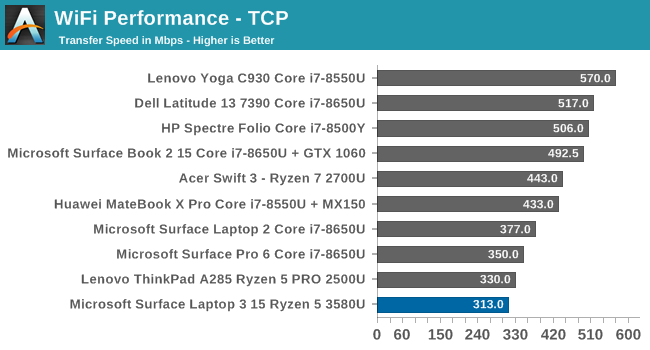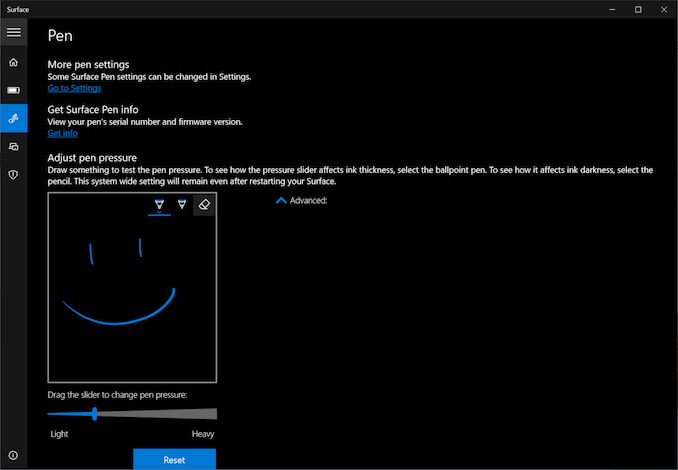The Microsoft Surface Laptop 3 (15-Inch) Review: AMD Ryzen Surface Edition
by Brett Howse on October 21, 2019 9:00 AM EST- Posted in
- Laptops
- AMD
- Microsoft
- Surface
- Ryzen
- Surface Laptop
- Surface Laptop 3
Wireless
If there’s been an Achilles heel of the Surface lineup, it has been Microsoft sticking to low quality wireless adapters. Surface devices have almost exclusively utilized Marvel AVASTAR wireless, which has been not only slow, but unreliable. Over the years, the reliability has improved, but the overall solution was never up to where an Intel wireless adapter would perform in terms of both performance and reliability. The only time the Surface team has leveraged something other than Marvell was with their LTE devices, which would use a Qualcomm wireless adapter. Unfortunately, it wasn’t really any better than the Marvell one.
Luckily that has changed for the current generation of Surface devices. For the Intel-based devices, Microsoft has adopted Ice Lake's semi-integrated Wi-Fi 6 (802.11ax) solution. Unfortunately AMD doesn't offer an equivalent here, so Microsoft is using a Qualcomm wireless adapter in the AMD-based 15-inch Surface Laptop 3.

The results are not great. While there haven’t been any reliability issues at all, the performance of the Qualcomm wireless was frankly terrible. It is almost 2020, and we have wireless networking solutions that can reach over 1 Gbps with just a 2x2 configuration, but the 15-inch Surface Laptop 3 achieved a meager 313 Mbps.
Audio
Microsoft has outfitted the Surface Laptop 3 with Omnisonic speakers featuring Dolby Audio Premium, and while the pairing does not get excessively loud, the sound quality is fantastic, with much better low-end than you’d get on most laptops of this size.
At around 76 dB(A) measured one inch over the trackpad, there’s enough volume for most situations, and the improved sound quality is a great trade-off over really high dB speakers with no range.
There are two far-field microphones as well, enabling Cortana interactions if desired.
Thermals
The advantage of a larger laptop like the 15-inch Surface Laptop 3 is that it should not have much of an issue cooling a 15-Watt TDP, and the laptop was stress tested to find out if that was the case.
Interestingly the CPU on its own only pulls 9-10 Watts under sustained load, with a brief peak of a hair over 15 Watts. This is well under a typical Intel 15-Watt CPU which can pull well over 30 Watts for burst and sustained power draws can be over 15 Watts if the cooling system can handle it. Despite the lower than expected power draw under load the CPU is still able to maintain 3 Ghz or higher.
The cooling solution is very solid, and unless you are really working the laptop it stays silent for most of the time. Meanwhile if you do need to use everything the laptop has, the fan only gets up to 46 dB(A) measured one inch over the trackpad, which is not very loud. The tone of the air movement is a bit harsh though, but never gets to be a problem.
Software
As is typical of a Surface device it comes with very minimal software. There is the normal Windows apps, some of the Windows crap-ware that all machines ship with, and the Surface App, which lets you adjust the pen pressure, see the battery of connected Bluetooth devices, such as the pen, and get support if needed.
One thing that is absent though is the AMD Software Center, so you can’t adjust any of the typical AMD settings. Trying to download this from the AMD website will result in a “no valid hardware found” message. This is unfortunate, since you won’t be able to easily disable things like AMD’s Vari-Bright, which automatically lowers the screen brightness on battery. AMD let us know that they won’t be bringing this to the Surface Laptop 3 either, so if you are a fan of the AMD Software Center, don’t expect it anytime soon on this AMD powered device.












91 Comments
View All Comments
Marlin1975 - Monday, October 21, 2019 - link
For being the base AMD Ryzen model CPU/GPU it performs much better than I though it would. Hopefully you can get a Ryzen 7 version to test soon as well.Rickyxds - Monday, October 21, 2019 - link
The AnandTech is protecting Intel and UHD performance, Why they don't show UHD 630 performance in Rise of the Tomb Raider?they don't show but I will tell you! in the same configuration the UHD 630 offer only 20 fps.
You can search on web the uhd 630 performance on Rise of the Tomb Raider, internet can show!
cyrusfox - Monday, October 21, 2019 - link
UHD 630 is the old Intel GPU(Gen 9.5) found on coffee lake. The new surface has ice lake chips has Gen 11 GPU, Iris plus with 64 EU. Supposedly twice as fast as the prior generation.I am sure we will see cross comparison reviews, especially when someone gets Enterprise 15"(Intel version) to compare straight to consumer 15"(AMD).
justin.anthony.hall - Monday, October 21, 2019 - link
mine is delivered tomorrow, i7 version. I'll let y'all know.mooninite - Monday, October 21, 2019 - link
Early tests of Ice Lake Iris show it is more of the same old junk from Intel. Nothing special. Vega still wins.0ldman79 - Sunday, December 15, 2019 - link
It's just like their previous IGP.Intel brags about "up to 64 EU IGP" then 99% of their SKU have 24 EU or less. One model has 64 EU and that's only their high end i7 K model. Who the hell is going to buy a $600+ CPU and run the IGP? Even if it is Intel's best IGP it's still below a 750 Ti.
Ryan Smith - Monday, October 21, 2019 - link
"Why they don't show UHD 630 performance in Rise of the Tomb Raider?"As you've correctly noted, the short answer is that it's very slow. Too slow to even justify the time benchmarking, unless you like framerates in the teens.
Ultimately the Ryzen APUs are fast enough that we treat them like low-end dGPUs, and that includes running AAA gaming benchmarks on them. The Gen 9.x GT2 GPUs, on the other hand, are decidedly a tier lower for intensive gaming workloads.
Teckk - Monday, October 21, 2019 - link
Good win for AMD not battery life is a bit underwhelming. With the new 1W display for new laptops (based on IceLake?), this needs some serious improvement. AMD needs Ryzen mobile on 7nm soon.A decent laptop but, 128 GB as baseline, really? Good to see they're not offering 4 GB RAM at least. Add another USB port and this is a good enough machine for light home usage.
eastcoast_pete - Monday, October 21, 2019 - link
Thanks for the review! Unfortunately, it confirmed several of my fears - the AMD version of the new Surface is definitely usable, but behind even the previous (Intel) generation of this premium laptop line. The Wifi choices made by MS are indeed questionable at best, while the low battery life points to the basic problem of using a chip not designed for mobile use in an ultraportable. Really wish AMD would roll out a true Zen2+ or better mobile APU with better power management. For now, it continues to play second fiddle to Chipzilla's offerings.GreenReaper - Monday, October 21, 2019 - link
Microsoft is likely to be one of their first customers for this, too... in their consoles. Realistically we'll only start seeing new PCs with equivalent APUs around that time - most likely with 802.11ax Wi-Fi as well in the case of the inevitable Surface Laptop 4.